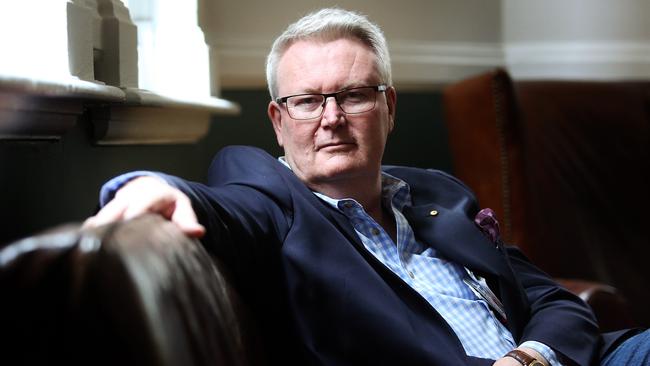The footy club’s crisis shines a spotlight on business values
It’s been a long journey for organisations keen to reflect community expectations.

The push for corporations to spell out their values and take a stand on social and political issues such as the proposed advisory Indigenous voice to parliament is often seen as a product of “woke” thinking or political correctness. In reality, the pressure for companies to dedicate time and staff to develop policies on values emerged from within business as part of managing risks to reputation and ultimately profits.
Twenty or 30 years ago, the focus was on “corporate social responsibility” and minimising pollution and the rehabilitation of the environment after mining, for example. There was discussion about aligning values of the company with those of staff, but the implication was values focused on hard work and profits rather than where everyone stood on racism.
Back then culture was contested territory, with many in business condemning CSR or the notion that companies owed any responsibility to stakeholders such as staff or the public. The only corporate responsibility, according to many at the top, was to ensure shareholders made money. It took a few years for a broader debate about the responsibility of corporations to emerge along with discussion about the culture of workplaces – the need to stop bullying or harassment, or to hire without bias – to become commonplace in management courses and the literature. The mainstream press took even longer to stop seeing culture as a joke, a fad.
Fast forward to the past five or so years when corporations began hiring people with titles such as chief reputation officer, chief purpose officer, chief diversity and inclusion officer. Today, few organisations can avoid a discussion about values and how far to go in articulating positions on social and community issues.
The complex challenges facing corporations were highlighted last week at the Essendon AFL club when new CEO Andrew Thorburn stepped away because of a potential clash over his and the club’s beliefs. The incident was portrayed by some as an example of political correctness dictating the play; for others it was a prime example of how far organisations have come in taking a stand on issues they consider crucial to their brand and operation.
■ ■ ■
Simon Longstaff, executive director of the Ethics Centre based in Sydney, offers a potted history of the evolution of values and culture in business: “There was a time in Australia and probably in other countries where the foundations for culture, if they came up at all, were simply assumed to be aligned because of a certain kind of monocultural dominance.
“In the 1950s in Australia, you probably wouldn’t have found too many people who would question the role of religion in society or the Protestant ascendancy in the battle with Catholicism. There’s just been a whole lot of tropes that were taken for granted … even to the point of assumptions about race and who was superior. There were some corporations that wouldn’t hire Catholics and Catholic organisations that wouldn’t hire Protestants. It was all just taken for granted and people knew that institutions had particular characters.
“Then we went through a period when that rather simple world view where people knew where they stood and what was the right thing or the wrong thing to do … (changed) to a much more complicated world in which the level of complexity in society meant people began to ask: how do we manage these circumstances so that there’s some predictability in what we do, how do we manage risks?”
Longstaff says from the late 1970s to the ’80s a rules-based, compliance approach emerged under which employees did not have to share any of the company’s values but had to obey the rules. That suited many people because they did not rely on work for their identity, he says.
“The real expression of their life took place in their community, on the sporting field, anywhere but work, so if you obeyed the rules, you did your job, you got paid and then you got back to your life. This notion that a company could regulate its way to some kind of stability and security grew within corporate boardrooms, and directors became some of the most prolific regulators in the land.”
Meanwhile, Longstaff says, the military had the jump: “They were the world’s most effective risk managers and performance drivers because, for them, if you get it wrong you get killed or wounded.” The military had worked out, about 20 years before business, that compliance alone did not work because “you can have all your systems in place but they break down the moment you start to engage”.
Longstaff talks of the military concept of the “strategic corporal” and their ability to change the fate of nations thanks to social media.
“In the old days (a general could give orders) and what a particular corporal was doing down in the mud and the blood had no particular impact,” he says. “But by the end of the 20th century, and certainly the period after mobile phones became more ubiquitous, a corporal could burn a copy of the Koran, take a film, have it uploaded into the cloud, have it distributed through social media, and a corporate, not a general, could generate strategic effects so profound they would have an impact in a president or a prime minister’s office.”
Longstaff’s point is that this was also happening in business, where bad behaviour by an employee in a call centre or a shop could be filmed and uploaded and affect the reputation of the company. He says: “Everybody now can generate strategic effects. And that’s when you find the inadequacy of the old rules-based, compliance system. And if you create a system in which no one can choose to do anything wrong, then inadvertently you have a system in which now I can’t choose to do anything right. People got to a point where they were checking boxes and ticking this and doing that but never developing the capacity to make responsible decisions.”
■ ■ ■
While corporate social responsibility and the need to be good corporate citizens was accepted by the early 2000s, the battle over “corporate culture” reached a high point after the GST and the crisis in the financial sector. When in 2016 Australian Securities & Investments head Greg Medcraft announced ASIC would include corporate culture in its oversight of companies, it generated a backlash from some sections of business.
Most outspoken was David Murray, the former head of the Commonwealth Bank, who headed the 2014 inquiry into the financial system. At one event, in comments he later regretted and apologised for, Murray compared the corporate watchdog’s actions to those of Nazi Germany. He said it would be “absolutely impossible” for ASIC to reform culture, saying such moves were anti-competitive and inefficient. Despite Medcraft later saying that culture could not be regulated by “black-letter laws”, ASIC’s focus on the need for boards to take responsibility for organisational behaviour continued to attract criticism in this period.
Some, however, got the message. In a note to clients at the time, senior lawyers at Minter Ellison said: “People have long known that a poor culture can lead to bad behaviour and worse. Yet regulators have never tended to join the regulatory dots between misconduct and a poor culture. Until now. ASIC sees corporate culture as a big driver of conduct. In short, ‘bad culture leads to bad conduct’, which in turn is ‘a major risk to investor trust and confidence’.”
The lawyers said ASIC recognised there was no “one size fits all” approach but it was “clearly seeking to effect a change in corporate attitudes”.
■ ■ ■
ASIC wasn’t the only institution looking at the potential risks of poor culture in an organisation. The impact of the Australian Prudential Regulation Authority proved decisive in corporate attiudes to culture. In 2019 APRA introduced the Prudential Standard CPS 220, a tool designed to help companies manage risk.
According to Simon Longstaff, APRA was saying to companies: “It’s not just about your rules and surveillance and compliance systems, we need to know the core values and principles by which you judge something to be good or bad, right or wrong and you need to be able to measure it, you need to be able to tell what you’re doing to make sure that there is an alignment between what you say and what you do.”
Along with these changes, the evidence emerged from researchers like Jim Collins, whose books, such as Built to Last, found the highest performing corporations did not focus on profit maximisation but “had one thing in common – a strong alignment between what they said they stood for and what they did”.
Longstaff says companies began to see that values and principles drive every decision in terms of performance and risk management. “Without the alignment, you don’t get the performance,” he says.
Companies realised they had to recruit people who didn’t simply obey their rules because rules could never deal with the complexity facing a business: “You needed to recruit people who were not clones but had a general affinity with the values and the principles of the organisation.”
He says that today’s companies don’t have to make public pronouncements on issues but they need to find an alignment between corporate and individual values if they want to minimise risk and maximise profit.
“It means the ecology of business is evolving. The old ecology was that you were distinguished in the marketplace by what you did. You either did it better or worse, whether it was product design, or price or whatever. None of that can be a competitive advantage any more because your competitors using modern technology can see what you’re doing and can replicate your pricing and your product features in a heartbeat.
“What they cannot replicate is what you stand for because that takes ages to build and develop. So the ecology of business now is moving from an ecology of doing to an ecology of meaning or being.”
It’s not one size fits all.
“There’s lots of room for different types of corporations,” says Longstaff. “You can have a corporation on one corner that believes its most important value is trust and on the other corner one that believes in cunning. It’s OK for them both to be there as long as they can find capital, clients and employees.”
Longstaff cites an example from Europe in the 13th century, when the modern university emerged, of how different approaches can succeed: “Bologna was entirely student-centred, all about giving the students what they wanted; Paris was all about the authority of the masters. Both of them competed for capital and students. They were completely different in their proposition, but both succeeded because they both found enough of what they needed.”
In modern organisations it’s the same: if no one wants to work for you, if no one wants to buy your product, if no one wants to give you money by way of debt or equity, you’re just going to disappear in an evolutionary sense, says Longstaff.
He says many corporations are debating the Indigenous voice, with most taking a “cool-headed” approach. “If you look at any corporation, they want to be in a healthy, prosperous, united society because that’s what lowers costs and drives their ability to make sustainable profits as well as being the kind of place that their people want to live.
“(A company’s decision) will vary but it’s not as if they’re just doing it because everybody else is doing it. It’s naive to think that businesses are so lacking in strategic assessment that they just go along with fashion.”




To join the conversation, please log in. Don't have an account? Register
Join the conversation, you are commenting as Logout